If you want to know about the introduction of landscaping and its role or about landscape or terminology used in landscape, please click the link.
Vegetation plays an important role in the landscape, providing a range of benefits to the environment and the people who live in and interact with it.
1) General characteristics and uses of vegetation
- Among the most important materials used by the landscaper is an infinite variety of plants, including
- trees,
- shrubs,
- annuals,
- perennials,
- vines and
- grasses,
- The proper use of these plants can contribute greatly to the usefulness and beauty of a landscape.
- Depending upon the effect desired, the landscaper may group them in masses, arrange them in rows, or set them out individually in isolated but strategic positions.
- Plants have varying characteristics of flowering and fruiting; varying degrees of suitability to soil, temperature, light, and moisture; and varying resistance to pests and disease.
- Plants may be used for a landscape cover or for enclosure.
- They may be used to provide shelter and fragrance; to yield fruits, herbs, and vegetables; to enrich the landscape.
- The choice of plants is affected by the demands of design, the physical needs of the plants, and human preferences. With their varying habits,
- forms,
- textures, and
- colors, plants may be used to create interest and beauty as well as to serve practical needs.
- The design and maintenance of a landscape are closely related.
- The manner in which plants are used often depends upon the amount of care that can be given to them.
- Where care must be limited, it may be necessary at the outset to substitute paving for grass, to depend largely upon structural elements, or upon plants and flowers that are easy to manage, and to avoid plantings that require laborious trimming.
Plant Forms
- Plant forms should be chosen to fit the spaces for which they are intended.
- Nowhere will you find this rule more generally violated than at the foundations of homes, where an overabundance of planting or meaningless vertical forms are frequently seen.
- The selection of plant forms is subject to the guiding principles of good design, such as scale, balance, rhythm, unity, harmony, and proportion.
- A three-foot hemlock may look just right under the window when it is planted, but it is a forest tree, and in five years will cover the window entirely.
Textures
- Plants vary in texture according to the size and shape of their leaves.
- Leaf sizes range from the smallest leaves of heather and juniper to the sizable leaves of magnolias, palms, and elephant ears.
- Leaves may be linear, like pine needles, or lance, oval, or heart shaped.
- Individual leaves may vary too in their edges and points, their degree of thickness or stiffness, their veining, and their smoothness or roughness.
- The foliage arrangement—thin, dense, even, bunched, erect, stiff, pliable, tremulous—may affect the texture. Trees may lose their leaves in winter and show their branches and trunks.
- All these factors account for the different textures in vegetation, ranging from soft, delicate textures to the coarse textures of large leaves.
- Textures in turn may produce emotional reactions in the viewer, such as cheerfulness at the sight of glossy, gay leaves sparkling in the sun.
- An impression of majesty is conveyed by thick textures, one of quiet restfulness by uniform textures, where leaves are small, regular, and thick.
- Sparse, scattered, and broken textures may produce restless effects.
- Small textures may be used to give the illusion of distance when contrasted with larger textures close by.
Colors
- Color plays a large part in the selection of plants for a landscape.
- It is present most strikingly in flowers and fruits, and, to a lesser degree, in foliage and plant structure.
- Foliage ranges from gray to green to purple and red.
- In certain sections of this country, foliage bursts into riots of color in the autumn.
- Different types and colors of plants are available in different climatic zones, but in any zone plants can be selected to obtain agreeable color patterns.
- The bark of trees varies in color from the whites (of birch) through the grays, browns, and reds to near black.
- In general, color should be used in a disciplined manner as part of the overall design.
- Strong accents may be used to strengthen the visual effect.
- Gaudy showings in fancifully conceived shapes without organic relation to anything are to be shunned.
- In selecting plants, you should be familiar with the ranges of color available, and the possibilities for harmony and judicious contrast.
i) Trees
- Trees are found in a variety of sizes, forms, colors, and textures.
- They may be symmetrical like a sugar maple or irregular like a mossy-cup oak.
- They may be square (when clipped), round, elliptical, pyramidal, columnar, vase shaped, low branched, or high branched.
- Trees may have colourful leaves, flowers, fruit, or bark.
- They may vary in texture, as do a plane tree and a Kentucky coffee tree, a catalpa and a honey locust, or a tulip tree and a willow.
- These differences in texture make it possible for the landscape architect to achieve various harmonies and variations.
- The sizes and formation of various trees are shown in figure below.


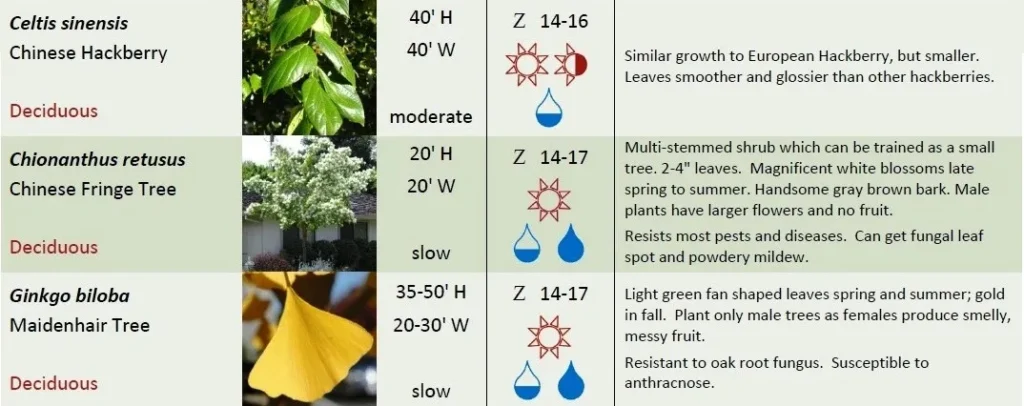



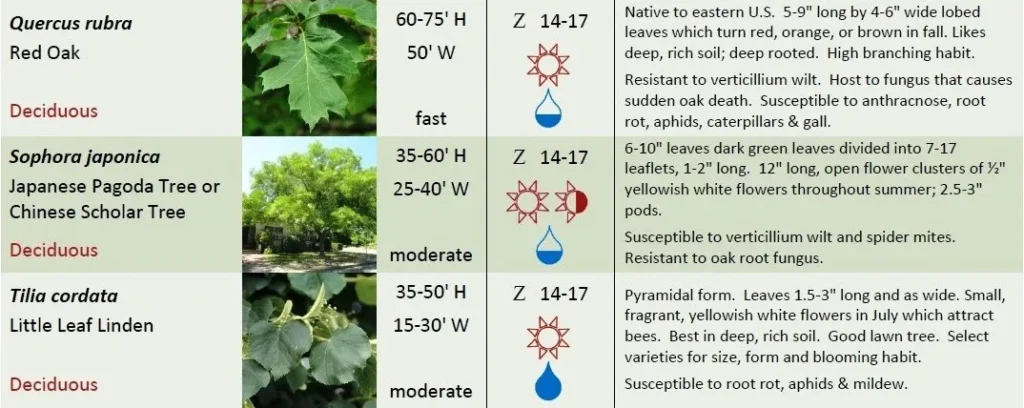

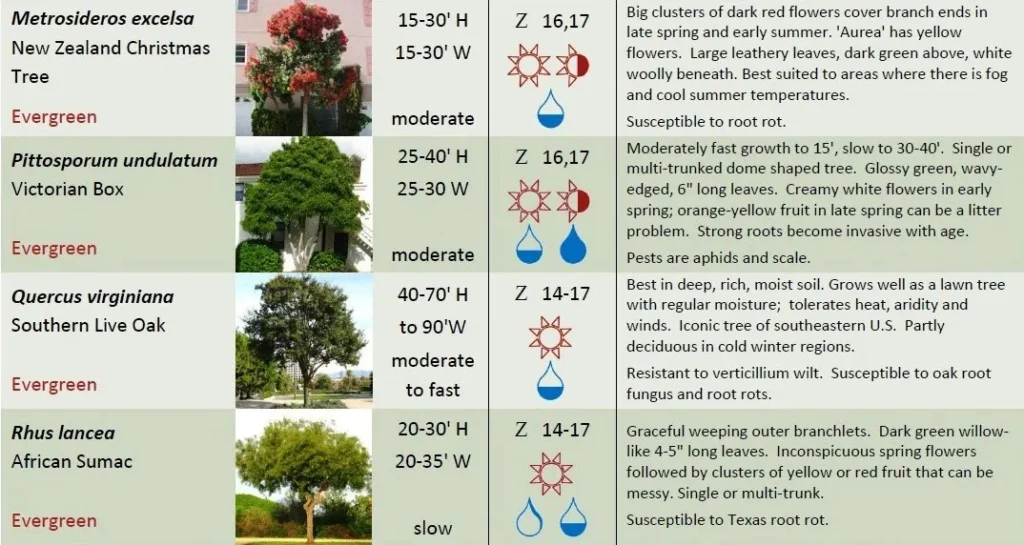
- A few trees are listed here according to certain characteristics.
Small trees noted for bloom
- Acacia, cherry, carnelian cherry, crabs, flowering dogwood, hawthorn, magnolias, redbud, and shad-blow
Small trees noted for autumn color
- Flowering dogwood, Amur maple, Tatarian maple, and sour gum
Large trees distinguished by autumn color
- Sugar maple, oaks, sassafras, and tupelo
Small trees conspicuous for fruit
- Mountain ash, cockspur thorn, and wahoo
Trees desirable for street planting
- Sugar maple, Norway maple, oaks, tulip tree, sycamore, hackberry, American linden, ashes, sweet gum, Chinese elm, and locust (These trees are long lived, strong, neat, not brittle, free of insect damage, with good foliage.)
Trees undesirable for street planting
- American elm (currently threatened by Dutch elm disease and phloem necrosis), silver maple (brittle and dropping branches), box elder, tree of heaven (messy), catalpas (untidy flowering), poplars, and willows
Columnar-shaped trees
- Deciduous trees: Pyramidal European linden, columnar Norway maple, columnar English oak, Bolle and Lombardy poplars
- Conifers: Arbor vitae, Cryptomeria, red cedar, Hicks yew
Weeping trees
- Horticultural varieties of numerous species: Maple, birch, beech, poplar, oak, willow, and elm
Trees for Windbreaks and Solid Screens
- Poplar, willow, spruce, hemlock, American beech, white pine, and hornbeam
Evergreen trees
- Fir, cypress, Cryptomeria, holly, juniper, spruce, pine, hemlock, thuja (arbor vitae), and Sciadopitvs (Evergreen trees retain their green mantle throughout the year and have many valued uses in landscapes.
- Some are pyramidal (firs), loosely pyramidal (umbrella pine and Japanese cypress), strong and beautiful (pines), graceful and dignified (hemlock).
- They are chiefly fine and dense, and vary greatly in color. Their character is distinct, positive, assertive.
- They complement and intensify the warm colors of other plants; they furnish dark shadows and heavy contrasts.)
ii) Shrubs
- Shrubs offer a wide range of characteristics.
- They, too, are both deciduous and evergreen and grow to various forms and heights.
- Some of the shrubs are shown in Figure below few shrubs are classified here according to certain characteristics.
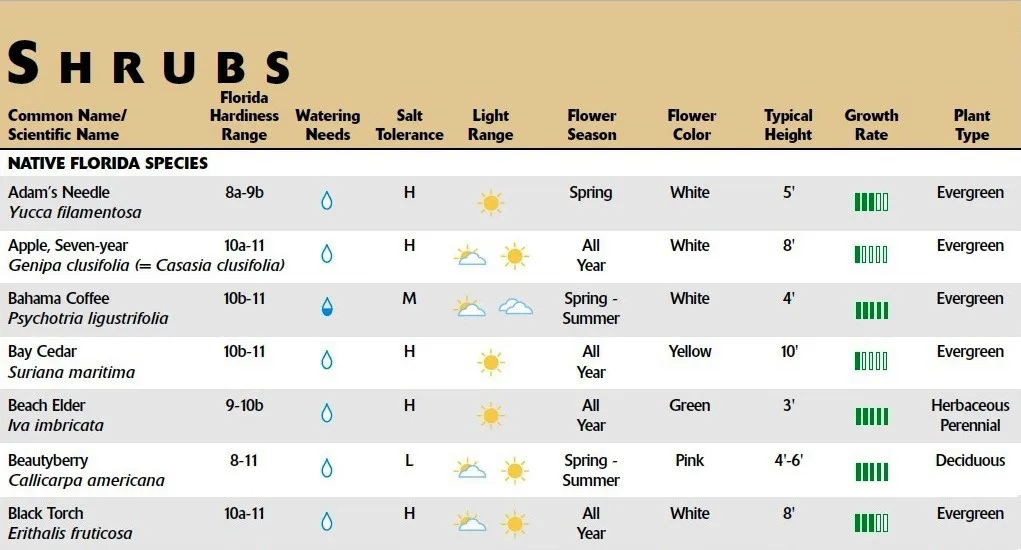
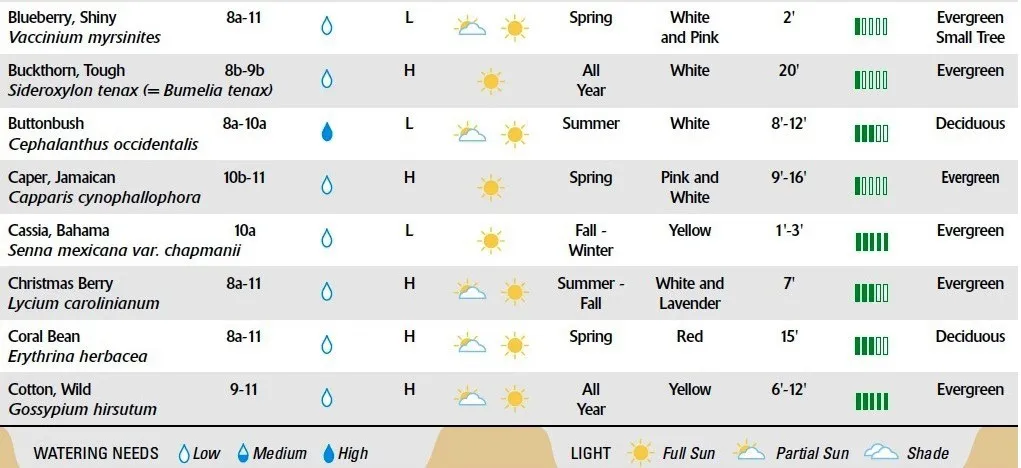
Low-growing shrubs
- Deutzia, Kerria, yellowroot, Thumberg’s spiraea (or spirea), goldflower, coralberry, and snowberry
Medium-growing shrubs
- Withe rod, Regel’s privet, aralia, flowering currant, Japanese snowball, Van Houtte’s spiraea, Rhodotypos, dogwood, forsythia, and Japanese bush cranberry
Tall-growing shrubs
- Tatarian honeysuckle, Japanese bush honeysuckle, mock orange, weigela, sheepberry, hybrid golden bell, lilac, and wayfaring tree
Smaller evergreens
- Prostrate juniper, mugho pine, dwarfish Japanese yew
Broadleaf evergreens
- Azalea, hybrid rhododendron, Pieris, Japanese holly, mountain laurel, abelia, mahonia, and leucothoe (These are available in dwarf and tall varieties, in diverse form and foliage.)
Shrubs for edging of walks and garden borders
- Hardy evergreen azalea, dwarf box, small-leaved holly, barberry, meadow rose, and Tom Thumb arbor vitae
Shrubs for hedging
- Low: Barberry, box, yew, Cotoneaster, dwarf cranberry, Spiraea Anthony Waterer, snow garland, and thyme
- Tall: Acanthopanax, arrowwood, winged euonymous, and Regel’s and Amur privet
Shade-loving shrubs
- Acanthopanax, coralberry, ninebark, and privet
Shrubs with showy fruit
- Japanese barberry (red), yellow honeysuckle, bittersweet and Cotoneaster (orange), fringe tree (blue), and buckthorn (black)
Shrubs according to soil preference or tolerance
- Clay: Cornus species, Crataegus, forsythia, Kerria, spiraea, and Viburnum opulus
- Sandy soil: Cotinus, Elaeagnus, Ligustrum, Lonicera, Rhus, spiraea, symphoricarpos, viburnum, and yucca
- Calcareous (limestone) soil: Alnus, Berberis, Betula, Ceanothus, cercis, Cornus, Corylus, Crataegus, Kerria, and rhamnus
- Peat soil: Arbutus, andromeda, kalmia, leucothoe, rhododendron, and vaccinnium
Seasons of bloom among shrubs
- April: Daphne, golden bell, Juneberry, and Japanese quince
- May: Barberry, white kerria, lilac, and silverbell
- June: Fragrant amorpha, Kerria, japonica, Deutzia gracilis, and oleaster
- July: Button bush, pepper bush, St.-John’s-wort, and Spiraea Douglasii
- August: Sweet alder, Hydrangea paniculata grandiflora, and blue spiraea
- September: Witch hazel, blue spiraea, and Spiraea conspicua
iii) Annuals
- Annuals are flowers that grow from seed, blossom, and die down in one season.
- They are obtainable in every color, can be used in a variety of ways, and can be raised at small cost.
- They may be mixed effectively with perennials.
- A few of them are listed here for convenient reference:
Some hardy annuals
- Larkspur, calliopsis, poppies, sweet alyssum, nigella, cornflower, pansies, and zinnias
Drought-resisting annuals
- White: Dahlias, larkspur, baby’s-breath, candytuft, petunias, sweet alyssum, and verbena
- Yellow: Sunflower, zinnias, calliopsis, marigold, and portulaca
- Orange: Heliopsis, African marigold, and California poppy
- Red: Cockscomb, Helichrysum bracteatum, poppy, and rose moss
- Lavender: China aster, Drummond phlox, and hemiptelea
- Blue: Cornflower, larkspur, lupine, ageratum, verbena, and forget-me-not
Annuals according to height
- Less than 1′: Sweet alyssum, ice plant, lobelia, pansy, and portulaca
- l’-2′: Baby’s-breath, marigold, mignonette, and petunias
- 2′-3′: Amaranthus, Bertolonia, cotton, poppy, and scabiosa
- Over 3′: Castor bean, cosmos, giant hemp, and Nicotiana
iv) Perennials
- Perennials are flowers that live on for three or more seasons, while the so-called biennials live but for two years — they grow from seed one year, and flower and die the next.
- There are some 2000 species and variations of perennials, and if the iris and the dahlia are included as well, the number amounts to some 5000.
- Perennials are easy to manage and need little care.
- They grow under trees, among shrubs, in rockeries, along ponds, on banks, in borders, and in shade or sun.
- Most effective results may be obtained by planting perennials in masses of lights and darks, in a harmony of hues and tones, rather than by introducing many kinds with spotty results.
- A few of the perennials are listed here in selected groupings:
Perennials for massing
- Delphinium, Pyrethrum, columbine, Shasta daisy, violet, sweet lavender, coreopsis, sweet william, foxglove, and Canterbury bell
Perennials according to height
- Less than 1′: Candytuft, English daisy, forget-me-not; moss pink, rock cress, and shooting star
- l’-2′: Achillea, ptarmica, fragrant balm, columbine, Funkia subcordata, Lychnis viscaria, and Iceland poppy
- 2′-3′: Bleeding heart, Canterbury bell, cardinal flower, flameflowers, gas plant, and peony
- 3′-4′: Adam’s-needle, giant daisy, larkspur, Oriental poppy, sunflower, and tree peony
- 4′-6′: Coneflower, hollyhock, Japanese eulalia, joe-pye weed, and zebra grass
- Over 6′: Bugbane, giant rye grass, giant reed, sacaline, and sunflower
Ground-cover perennials for embankments
- Moss pink, Japanese spurg, bearberry, and periwinkle
Perennials according to color
- White: Achillea, ptarmica, Adam’s-needle, Astilbe japonica, daisy, day lily, and rock cress Lilac, magenta, purple: Beardtongue, blazing star, gas plant, fringed pink, rock cress, and shooting star
- Blue: Anemone blanda, Clematis davidiana, Rock Mountain columbine, forget-me-not, Iris laevigata, and larkspur
- Yellow: Columbine (chrysantha), coneflower, gaillardia, golden tuft, Iceland poppy, and sunflower
- Pink: Bleeding heart, hollyhock, Lychnis viscaria splendens, moss pink, peony, and dianthus
- Red: Anemone japonica, fragrant balm, cardinal flower, Clematis viorna coccinea, coral-bells, and peony
Fragrant perennials
- Gas plant, golden tuft, groundnut, rock cress, rocket sweet, and Scotch pink
Perennials for shady places
- Anemone Pennsylvania, bluebell, bugleweed, Helleborus niger, Phlox divaricata, and shooting star
Drought-resisting perennials
- Coneflower, inula, sedum, and Yucca filamentosa
For moist or low ground conditions
- Fragrant balm, cardinal flower, Funkia, Iris laevigata, joe-pye weed, and Ranunculus aquaticus
Perennials with striking foliage
- Adam’s-needle, Anemone japonica, eulalia, Funkia, giant reed, and plume poppy
v) Vines
- Vines that cling to brick, stone, or concrete, or climb trellises or wires, provide shade, concealment, and ornamentation.
- Such vines need to be used judiciously.
- Overuse and overgrowth of vines can smother structures otherwise worth looking at.
- Vines can be employed to advantage on railings and trellises.
- One kind of vine can often be used with another kind, or with an associated shrub planting.
- Twining vines, such as Actinidia, Akebia, and Hall’s honeysuckle, can be grown on any type of wall merely by attaching wire to the surface.
- Clinging vines should not be used on wooden houses, because they make repainting of the house difficult and tend to keep the wood surface damp.
A few vines and their classifications are listed as follows:
Clinging types
- Boston ivy, English ivy, trumpet creeper, and winter creeper
Climbing types
- Actinidia, bittersweet, clematis, Hall’s honeysuckle, rambler roses, and wistaria
Woody perennial vines
- Akebia, bittersweet, matrimony vines, silk vine, trumpet creeper, and Chinese wisteria
Annual vines
- Balloon vine, scarlet runner bean, canary-bird flower, ipomoea, and maurandia
Most popular vines
- Actinidia, Boston ivy, clematis, cobaea, Dutchman’s-pipe, honeysuckle, English ivy, perennial pea, trumpet creeper, and wisteria
Valuable vines for flowering effects
- Rosa wichuriana hybrids, clematis, American trumpet vine, wistaria, and honeysuckle
Vines and fragrant flowers
- Actinidia, Akebia, cinnamon vine, groundnut, honeysuckle, and Periploca
Vines with valuable fruiting characteristics
- Akebia, Japanese clematis, bittersweet, rose, matrimony vine, Virginia creeper, and Actinidia
Valuable vines for shade
- Boston ivy, Engelmann’s creeper, Hall’s honeysuckle, Virginia creeper, and winter creeper
2) Peonies and Chrysanthemums
- Hundreds of varieties of peonies are available.
- Peonies can be had in a variety of colors — red, crimson, pink, white, yellowish white, or purple.
- While they may be planted in a perennial border, or in front of shrubbery, they do best in separate beds.
- Chrysanthemums are one of the glories of the autumn.
- They include large-flowered, pompon, and button varieties, in many shades and mixtures of color.
3) Roses
- The principal types of roses are the hybrid teas, hybrid perpetuals, polyanthas, hardy climbers, and shrub roses, including the rugosa hybrids.
- The hybrid teas are the most common.
- The hybrid perpetuals are quite hardy and are especially suited to the more northern states.
- Polyanthas are dwarf and bush plants.
- Hardy climbers are suitable for fences, arbors, trellises, and banks.
4) Bulbs
- No garden should be without its bulbs and their brilliant and beautiful flowers that appear throughout the summer.
- Nothing can exceed the brilliance and variety of color of bulbous plants, although few of them are desirable for their foliage alone.
- For that reason, they show up best if grouped with other foliage-covered plants.
- Many of them thrive and blossom year after year.
- A friable, well-enriched, sandy loam suits them best.
- The hardy bulbs can remain in the ground from season to season, while the more tender ones, such as gladioli and dahlias, must be lifted and wintered under cover.
i) Hardy bulbs
- Hyacinths, tulip, narcissus, triilium, spring colchicum, crown imperial, dog’s-tooth violet, and anemone
ii) Sequence of bloom
- April or earlier: Crocus, crown imperial, Chionodoxa, grape hyacinth, snowdrop, and Leucojum vernum
- May: Daffodil, hyacinth, jonquil, Leucojum aestivum, and tulip
- June: Anemone, harebell, Spanish iris, and Cuban lily
- July: Blazing star, star hyacinth, tigerflower, and zephyr flower
- August: Blazing star, gladiolus, giant summer hyacinth, hyacinth squill, and tigerflower
- September: Starry hyacinth, Guernsey lily, meadow saffron, and autumn snowflake
5) Iris
- The irises are among our most beautiful flowers and come in a considerable range of colors.
- Many of them are hardy and easy to grow.
- They include the bearded, or German, iris in low, intermediate, and tall forms.
- This type grows from thick roots, or rhizomes.
- The beardless and bulbous group includes the Siberian, Japanese, and water irises, well suited to the southern California climate.
- Bearded irises can be planted in a perennial border, in front of shrubbery, or in a bed by themselves.
- Dwarf types can be used as edgings for flower borders.
6) Rock Gardens
- The purpose of a rock garden is to show off either existing rock outcroppings or boulders with exciting sculptural values, or to create rock effects.
- Whatever the purpose, a rock garden provides a home for diminutive plants.
- The treatment of the component rocks and flowers in such a garden requires a high degree of artistry.
- A common mistake is to try to form a rock garden from a pile of rocks in a small, level front yard.
7) Placement of Rocks
- The rocks in a rock garden should look as though they belong to the site.
- They should be set solidly and firmly.
- If possible, stones native to the region should be used.
- Cut stone with flat surfaces should not be used.
- Sedimentary rocks which occur in nature with horizontal cleavage lines should be laid horizontally.
- Stones that are longer than they are wide should be laid horizontally.
- The largest stones should be placed at the bottom, with the broadest face down and the weathered surfaces exposed.
- Each stone should be laid so as to contribute to a look of stability.
- Rock arrangements are subject to the same general principles applying to other phases of landscapes.
- Each stone should be laid so that water runs back into the rock openings.
8) Rock Garden Plants
- The purpose of a created rockery may be to keep soil from washing down along steps or to serve as a dry wall for flowers.
- Since alpine and other plants used in rock gardens require a maximum of winter sun, they should be planted with that in mind.
- These plants should not be allowed to burn in summer.
- Ample drainage must be provided.
- The pockets and crevices that are created for plants should contain soil favorable to their growth, or else plants should be selected to fit the existing soil.
- A deep, moist soil is good for most rock garden plants.
- Peaty soil is best for members of the heath and orchid family.
- A soil composed largely of crushed rock or gravel is best for mossy and starry saxifrages and low-growing sedums.
- Leaf mold favors the primrose and lily families.
9) Planting Details
- The rock garden should not be planted too thickly.
- Enough space should be available for each plant to develop. Several plants of a kind grouped together are more effective than individual plants scattered here and there, each plant different.
- Plants such as low-growing sedums should be placed in the sunniest positions; the more delicate ones, such as alpine primulas, should find shelter in nooks.
- Such plants as cerastium and dwarf phlox may be used to overhang ledges.
- Some plants, wild ginger for one, can get a foothold on the steepest slopes.
- On the tops of rocks and in most conspicuous locations, the Acanthus mollis, Spiraea aruncus, and columbine can be used to advantage.
- Because spring-blooming bulbs bloom early and don’t interfere with rock plants, they may be spread in masses among the alpine plants.
- There are thousands of alpines and dwarf perennials for you to choose from.
- Some dwarf annuals may be included, or dwarf species of bulbs, iris, and broad-leaved evergreens.
- Among the numerous plants that can be used in rock gardens are the following few classified groups:
Plants to be used in soil pockets
- Golden tuft, Carpathian harebell, Scotch pink, hardy candytuft, tunica, double-flowered lychnis, shooting star, stonecrop, and gypsophila
Plants for overhanging ledges
- Arabis alpina, Daphne cneorum, Phlox subulata, stonecrop, Veronica rupestris, and myrtle
For deepest recesses
- Lily of the valley, showy lady’s-slipper, large yellow lady’sslipper, bleeding heart, Japanese spurg, violets, polvgonatum, and Trillium grandiflorum
For conspicuous positions
- Columbines, gas plant, foxglove, eryngium, lychnis, Oriental poppy, and fritillaria
In moist positions
- Calla, Indian paintbrush, forget-me-not, Potentilla, and buttercup
Evergreens
- Mugho pine, andromeda, dwarf box, Erica vagans, spreading yew, Daphne cneorum, and Retinospora obtuse
10) Value of Lawn
- A lawn is the best general-purpose ground cover.
- Few things are more satisfying to the eye than a great expanse of well-attended lawn.
- Such a lawn may give a marked impression of size and restfulness.
- A satisfactory lawn should have good drainage, and proper construction and seeding and should be easy to keep up.
11) Preparing Ground Surface
- One of the first requirements for a lawn is that the ground be well graded and free of debris, trash, clods of earth, and stones.
- This means that there must be even slopes and gently flowing curves, with all irregularities, hummocks, or off-level places eliminated and smoothed into evenly flowing surfaces.
- When a house or other structure is to be erected, the topsoil should be removed and piled up for future use before any excavation is undertaken.
- It is well to remove the topsoil for a distance of 15′ to 25′ beyond the outlines of the building.
- To divert drainage from the foundation walls, the soil surface should be sloped away in all directions from the structure.
- At the bottom of the foundation, drain tile may be needed with connections to the storm sewer in the street.
- The real home of grass roots is in the topsoil layer to a depth of from 5″ to 6″.
- If there is not sufficient depth of topsoil present, soil should be brought in.
12) Improving Soil
- As the grading for a lawn approaches its final level, additions can be made to the soil to improve the physical condition of the soil.
- The organic additives that may be used include natural manures, sewage sludge, and cottonseed or soybean meal. The inorganic materials are the chemical fertilizers.
- When the grading has been completed, the surface is ready to be smoothed down and rolled.
13) Seed and Planting
- The best time to plant grass seed varies with the climate.
- The spring is the time favored in the South, whereas in the Nordi early fall is best, although seeding can be done in the spring as soon as the ground can be worked.
- In choosing seed, you should keep in mind the qualities of texture, density, smoothness, and uniformity that you desire.
- A coarse-leaved texture is less pleasing to the eye than a fine-leaved one.
- Timothy and orchard grass have coarse foliage; the red fescues and bent grass are fine in texture when closely mowed.
- You should know what grasses will grow in a particular locality, in a particular soil, in sun or in shade.
- Here are a few of the grasses available and their special characteristics.
- Kentucky bluegrass has creeping underground stems and a vivid bluish-green color.
- It is semidormant during summer, and requires a sunny exposure and a fairly good, well-drained soil.
- It takes three years to mature fully, lasts indefinitely, and improves constantly. Short mowing to less than 1 ½” seriously weakens the grass and gives weeds a chance to grow.
- This grass is slow to start, and a temporary, or nurse, grass is sown with it.
- Marion Kentucky bluegrass is a bluegrass that looks something like Kentucky bluegrass but withstands closer mowing.
- It is slow in developing a thick sod and should be sown with a temporary grass.
- Rough-stalked bluegrass is best for moist, shady spots, but is unsuited to hot, dry conditions, or to areas to be used for play and other activities.
- Fescues have stiff, wiry leaves that make them hard to mow, but good for use in playgrounds and athletic areas.
- They like well-drained, fertile soil, but grow on droughty soil, in either sun or shade.
- They dislike clipping to less than 1 ½” and are not favored by hot and humid weather.
- Colonial bent grass is a dense and mat-forming turf.
- It grows rapidly and thrives in summer when Kentucky bluegrass and the fescues are rather dormant.
- It withstands close clipping, but suffers the disadvantage of starting late and stopping early.
- Its moisture and fertility needs are high, and it is susceptible to disease.
- Creeping and velvet bents form a densely matted lawn and are used primarily for putting greens.
- They require frequent mowings, and top dressings once a year.
- Redtop and rye grasses germinate rapidly and are used either alone for temporary lawn effects or in mixtures to hold soil in place until slower grasses take hold.
- They do not stand up long under close clipping.
- Meyer zoysia makes a dense turf, but it is a warm-weather grass that turns completely brown with the first frost and remains so until late spring.
- Clover makes an early start in the spring.
- It will grow on poor soil and will help to supply the soil with nitrogen.
- It offers the disadvantage, however, of growing in patches with uneven results. Also, it stains clothing and is slippery in wet weather.
- Bermuda grass is the most common and desirable grass in the South.
- Other creeping types used in that area are centipede blue couch grass and the Manila grasses.
- These are propagated better vegetatively than from seed.
- Grass-seed mixtures are preferred to a single species, because mixtures produce satisfactory turf more quickly than do single species of grasses.
- The nature of the soil upon which the turf is to be grown will have a lot to do with your choice of grasses.
- Kentucky bluegrass, for example, is a lime lover.
- Bent grasses and fescues tolerate moderate acidity; fescues give best results on sandy soils; redtop and meadow fescues prefer wet soils, while sheep fescues thrive in dry soils.
- Immediately before any seed is sown, the soil must be raked and smoothed.
- The seed can be sown either by hand or with a seed spreader, and preferably on a calm day so that the seed will not blow about.
- After the seed has been sown, the ground should be rolled to embed the seed in the soil.
- Where erosion presents a possible problem, slopes can be covered with hay, straw, or burlap (with strips staked down), to keep the seed from washing away before it can take root.
14) Watering and Mowing
- The seeding should be followed by a fine spray of water.
- The seeded area should thereafter be watered twice a day.
- As the seed germinates, the amount of water applied at one time may be increased and the frequency of application reduced.
- The grass must be mowed often, but not too closely; it must be well fed and leaves must be raked off.
- Later, it may need repairing, reseeding, and rebuilding.
- Certain bugs may appear, such as beetles, chinch bugs, sod webworms, and ants.
- Lethal doses of chemicals, such as Chlordane, DDT, or lead arsenate, will be necessary to rid the lawn of these pests.
- If and when weeds make their appearance, there are potent weed killers available for dealing with them, or they can be pulled by hand with the aid of a weeder.
- Brown patches of fungi are treated with fungicide.
15) Sodding
- For immediate lawn effects in any season, for steeply sloping areas subject to erosion, or for edges of drives and walks, you may employ sodding.
- The main objections to sodding are cost, the difficulty in securing sod, and the possibility of its heaving in winter.
- Sod is cut into pieces of convenient length, width, and thickness, and the pieces are put in place without crowding to ensure an even surface.
- It is best to prepare the sod the afternoon of the day before it is to be laid.
- Both the ground and the bottom of each piece of sod are moistened, and the sod is laid.
- The junctions of the pieces are filled with fine soil and the sod is beaten down gently with a sod pounder.
16) Summary
- Plants include a wide variety of trees, shrubs, vines, flowers, and grass.
- They may be used to provide color, fragrance, fruit, ground cover, shelter, shade, and enclosures.
- As an element in design, they should be selected according to the compositional and functional effects desired.
Overall, the role of vegetation in the landscape is multifaceted and essential to the health and well-being of both the natural and human environments.